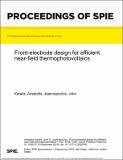Front-electrode design for efficient near-field thermophotovoltaics
Author(s)
Karalis, Aristeidis; Joannopoulos, John
DownloadPublished version (958.1Kb)
Publisher Policy
Publisher Policy
Article is made available in accordance with the publisher's policy and may be subject to US copyright law. Please refer to the publisher's site for terms of use.
Terms of use
Metadata
Show full item recordAbstract
© 2019 SPIE. In near-field TPV cells, the effects of the necessary front electrode are considered and shown to be of great importance. The electrode tradeoff between required high dc conductivity but low photonic absorption becomes detrimental for the efficiency in the very near field, as the thermal-emitter evanescent waves decay fast and are absorbed inside the electrode without penetrating sufficiently into the semiconductor. Therefore, near-field cells fail to deliver ultra-high power efficiently, as hoped. Still, efficient mid-power conversion is possible, and we compare the performance of several tunable-by-doping conducting-electrode materials. Moreover, novel phenomena arise in the near field, such as the inability to use thick transparent electrodes, while instead the feasibility of ultra-thin 'opaque' ones. The metallic-grid fingers exhibit an 'anomalous' shading loss, significantly smaller than predicted by geometry, by suppressing the thermal emission in the emitter regions across them.
Date issued
2019Department
Massachusetts Institute of Technology. Research Laboratory of Electronics; Massachusetts Institute of Technology. Department of PhysicsJournal
Proceedings of SPIE - The International Society for Optical Engineering
Publisher
SPIE-Intl Soc Optical Eng